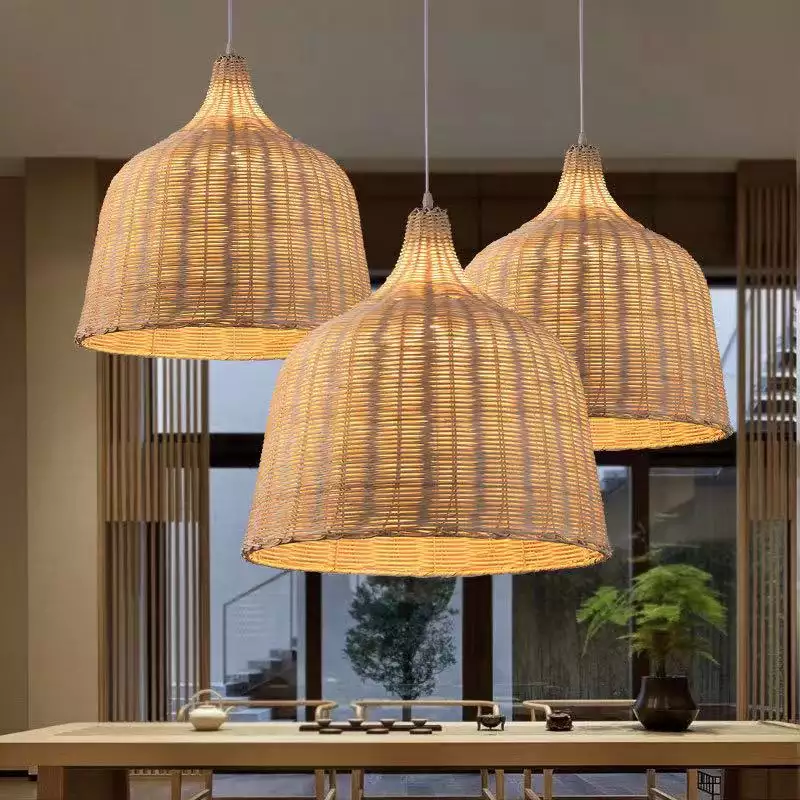There is always a restaurant that makes you feel at home and makes you not want to leave. Even if the food doesn't taste very good, the atmosphere will keep you there forever. Studies have shown that this is mainly due to the lighting in the restaurant.
Lighting design plays an indispensable role in the restaurant space. A suitable light can not only enhance the dining atmosphere, but also make the restaurant's decoration more coordinated, and even directly affect the customer's dining experience and satisfaction.
Lighting has an impact on people's psychology. It can determine whether your business will prosper or decline. Therefore, it is crucial to choose the right light for your restaurant.
So, how to choose the right restaurant lighting design? In this article, we will analyze in detail how to create an ideal restaurant lighting for you from the basic principles of restaurant lighting, design techniques to the application of different styles of lamps.
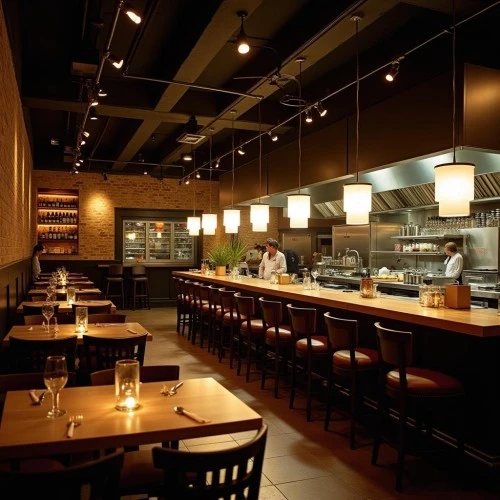
Best restaurant lighting design ideas
You may have noticed that high-end restaurants are usually dimly lit. This is because they are designed to provide a comfortable and warm environment. Low brightness also reduces glare, which often causes headaches and eye fatigue. Fast food restaurants, on the other hand, require a more lively environment, and bright lights can create this atmosphere.
1. Importance of restaurant lighting design
1.1 Enhance dining atmosphere
The lighting design of a restaurant directly affects the mood and experience of customers. Soft light can create a warm environment for customers to relax, suitable for family restaurants or romantic dating scenes; while bright light is suitable for fast food restaurants and efficient dining spaces.
1.2 Highlight the characteristics of the restaurant
The layout of the lights and the shape of the lamps can strengthen the brand image of the restaurant. For example, using rattan pendant lights can add a sense of warmth and simplicity to natural or pastoral style restaurants.
1.3 Show the color of the food
The right light can highlight the color and texture of the dishes, making the food look more delicious and tasty, thereby increasing the appetite of customers.
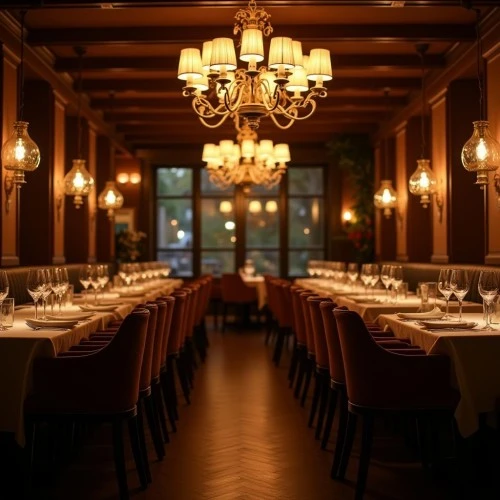
2. Core principles of restaurant lighting design
2.1 Zoning lighting
Restaurants are usually divided into multiple areas, such as dining areas, cashier counters and display areas, and the lighting requirements of each area are different.
Dining area: The light needs to be soft but not dark, and warm light (2700K-3000K) can be selected to create a comfortable atmosphere.
Cashier counter and entrance: Bright light (3500K-4000K) is required to make customers feel welcome as soon as they enter the door.
Display area: Use spotlights or light strips to highlight the beautifully presented dishes or drinks.
2.2 Choice of color temperature
Color temperature determines the tone and atmosphere of the light:
Warm light (2700K-3000K): Suitable for creating an intimate and warm atmosphere.
Neutral light (3500K-4500K): Suitable for modern style restaurants, providing bright and comfortable light.
Cold light (5000K and above): Not suitable for most restaurants, it can easily make the space look cold and unattractive.
2.3 Uniformity of light
The light distribution should be uniform to avoid partial over-brightness or over-darkness. Especially above the dining table, the light should be concentrated but not glaring, so that customers can see the dishes clearly while maintaining a comfortable visual experience.
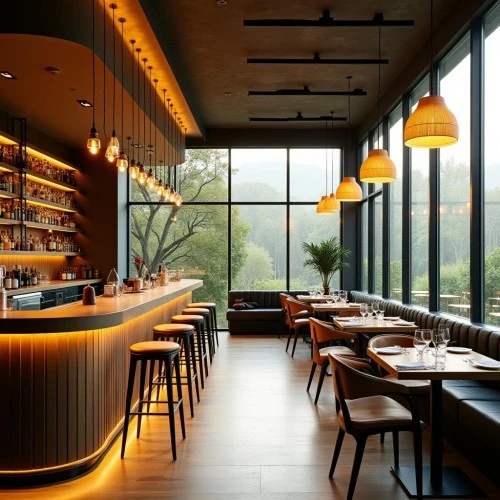
3. Types and matching of restaurant lighting design
3.1 Ambient lighting: support of basic light
Ambient lighting provides basic light for the entire restaurant, ensuring that every corner is covered by soft light. Recessed downlights, track lights and ceiling lights are common choices.
Recommended matching: Recessed lamps can be combined with decorative lamps, such as rattan chandeliers or bamboo wall lamps, to add a sense of hierarchy to the restaurant.
3.2 Accent lighting: highlighting the table and dishes
Accent lighting is used to highlight specific areas, such as the table, display cabinet or feature wall.
Pendant lights: Using low-hanging lightss above the table can focus the light on the center of the table, providing customers with a more comfortable dining experience.
Recommended lamps: Rattan pendant lights are an excellent choice. They not only provide soft light, but also form unique light and shadow effects through the woven texture of the lampshade, adding an artistic sense to the space.
Tips: The installation height of the pendant light is generally 70-90 cm above the table to ensure even light distribution while avoiding glare.
3.3 Decorative lighting: adding to the atmosphere of the space
The role of decorative lighting is to enhance the visual appeal and personalized characteristics of the space through the shape or light and shadow effects of the light itself.
Light strips: Hidden light strips can be used under the bar, on the edge of the wall or in plant decorations to provide soft background light.
Wall lamps: For natural style restaurants, you can choose bamboo or rattan wall lamps to echo the wooden furniture in the room.
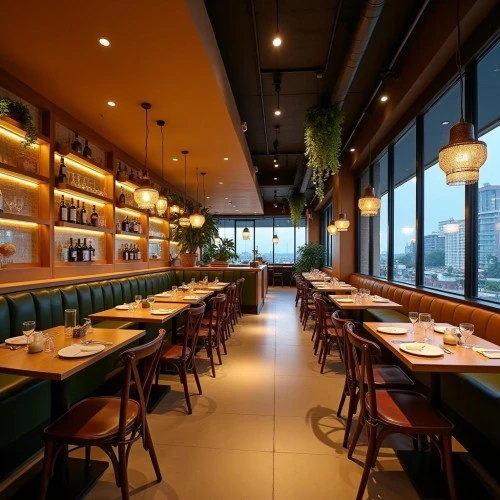
4. Restaurant lighting design and style matching
4.1 Modern minimalist style
Design suggestion: Use recessed lamps with simple lines or black and white geometric chandeliers, and the lighting is mainly neutral light.
Woven lamp embellishment: Use rattan chandeliers or lampshades in a small area to add a touch of naturalness to the modern style.
4.2 Industrial style
Design suggestion: Metal chandeliers, exposed bulbs and track lights are iconic lamps of industrial style, suitable for warm light to enhance the atmosphere of the space.
Matching skills: In order to soften the cold and hard feeling of industrial style, rattan floor lamps can be added to the corner area to increase the natural texture.
4.3 Natural pastoral style
Design suggestion: Choose lamps made of natural materials such as bamboo and rattan, and match them with wooden tables and chairs and green plants to create a natural atmosphere.
Light characteristics: Mainly warm light, matched with low-hanging chandeliers, making the light more concentrated and friendly.
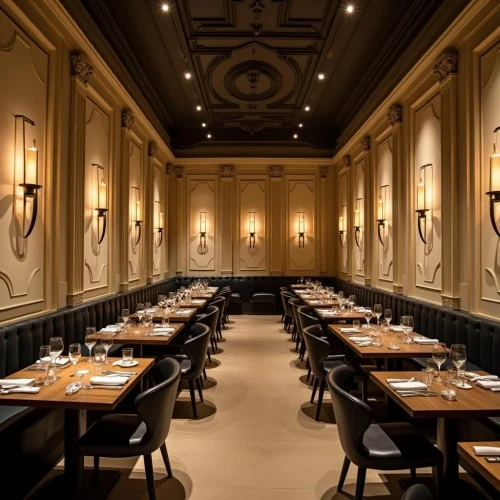
5. Details to note in restaurant lighting design
· Avoid light pollution and glare: Direct light sources may cause glare discomfort and affect the dining experience. It is recommended to use lampshades or diffuse light sources to soften the light.
· Combination of moving lines and lighting: The lighting design should be coordinated with the moving line layout of the restaurant. For example, evenly distributed embedded lamps are installed on the customer channel to ensure the comfort and safety of walking.
· Time and lighting adjustment:
The lighting requirements in different time periods are different:
During the day: Use natural light combined with low-brightness lights to save energy.
At night: Strengthen the warm light atmosphere to make customers feel relaxed and comfortable.
Use the intelligent lighting system to automatically adjust the brightness and color temperature according to time and scene.
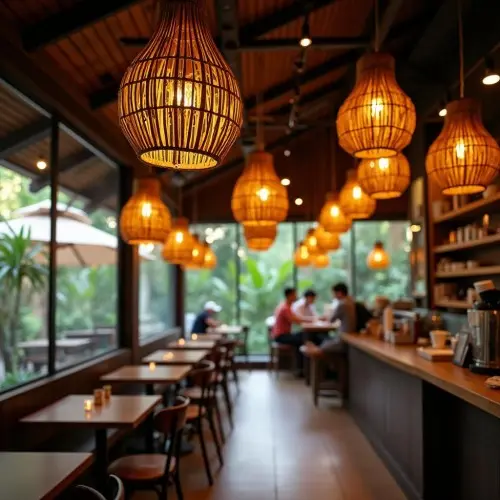
6. How to choose the right lamp?
· Choose according to the restaurant layout: The number and type of lighting fixtures should match the size of the space. Larger restaurants need to combine a variety of lamps to create a sense of hierarchy; small restaurants can use one or two lamps with a strong sense of design as highlights.
· Consider material and cleaning: For example, although rattan and bamboo lamps are exquisite and have a strong sense of atmosphere, they are easy to accumulate dust. It is recommended to choose a lampshade material that is easy to clean or maintain it regularly.
· Meet the needs of energy conservation and environmental protection: Give priority to LED light sources to reduce energy consumption while providing higher safety and longer service life. Paired with an intelligent control system, energy efficiency can be significantly improved.
Restaurant lighting design is the key to creating a dining atmosphere. Reasonable lighting layout can not only make the space more comfortable, but also enhance the brand image and customer satisfaction. From partition lighting to lighting style matching, every detail cannot be ignored. The moderate addition of woven lamps can not only increase the natural texture, but also inject a unique artistic atmosphere into the restaurant.
Whether your restaurant is modern and simple, natural and pastoral, or industrial, the right lighting design can make the dining space glow with a new charm. If you need a professional lighting design solution, contacting us is the right choice!
If You Are in Business, You May Like
Post time: Dec-20-2024










